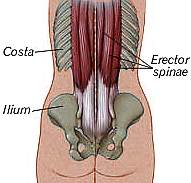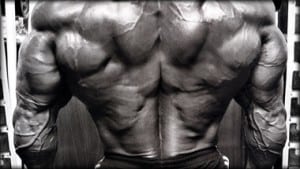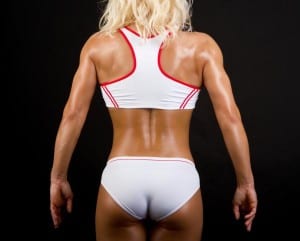While the lower back may be the easiest part of your back to acquire mass, it is also the easiest to injure. Think about all of the people with factory jobs spending all day picking up heavy boxes. These people will have very developed backs from doing this all day and they aren’t weightlifters or bodybuilders; they likely don’t do any of the best lower back exercises unless they are hitting the gym after a long, demanding workday.
The way people get injured isn’t necessarily the injured. I swear, you hear people all the time say all this shit about deadlifts being bad. This could not be further from the truth.
It is the way you perform the exercise. If you pick the bar off the ground with your back rounded like crazy, then yeah, of course, you are going to get injured.
How to Get a Muscular Lower Back
Like mentioned above, this may be the easiest muscle to get built up. Obviously, the deadlift will be the best exercise to utilize to achieve this goal.
Deadlifts can also be dangerous since a lot of people just never figure out how to use the correct form. Either that or they will try to go too heavy to inflate their ego and sacrifice form in doing so.
Here’s a hint: if you have to round your back in order to deadlift 500 lbs, then you should probably lower the weight. Drop the ego and use the right form, please.
Anatomy of the Lower Back
The lower back is a bundle of muscles and tendons, usually referred to as the Erector spinae. The muscles of the erector spinae are paired and run more or less vertically, extending through the lumbar, thoracic, and cervical regions, just to the side of the vertebral column.

This large muscular and tendinous mass varies in size and structure at different parts of the vertebral column. In the sacral region it is narrow and pointed, and at its origin chiefly tendinous in structure.
The lumbar region is larger and thicker but is eventually divided into three columns, which gradually diminish in size as they ascend and insert into the vertebrae and ribs. You can feel along either side of your spine and you will find where these muscles run, starting just above your hips.
Function of the Lower Back
The function of your lower back is quite simple. It is basically the most important part of your back because it is where all of the stress is placed. Think about those days where you are sitting down all day. Whenever you get up, you will feel some lower back stiffness. If your back is weak, you may slouch which will cause even more stress on your back. This is why it is important to strengthen your lower back muscles. This post works very well in combination with our top 5 best glute exercises.
The Top 5 Best Lower Back Exercises
In additional to the exercises listed below, every exercise you perform from a standing position will work your lower back. That includes overhead press, shrugs, standing triceps press, kettlebells, and most Olympic lifts. Train from a standing position as often as possible in your workout.
Conversely, if you have a weak lower back you might have a more difficult time maintaining proper form and posture when training in a standing position. This is most often the case with new or beginner athletes. If your lower back is weak, be sure to train using the exercises listed below to strengthen your lower back, before trying to support heavy weights from a standing position.
1. Deadlifts
Ah, the deadlift. This is without a doubt the most important lower back exercise. Hell, I will even go as far as saying it is the best back exercise. Actually, it is arguably, along with the squat, the most important exercise ever. It doesn’t just work your back. It works every single muscle in your body. That’s right, you are using your chest, traps, shoulders, calves, quadriceps, hamstrings, glutes, core, etc. You can definitely pack on the mass if you perform this exercise correctly. That is the key though: performing it correctly.
The lift: You will start by placing a standard 45 lb barbell on the floor. You will then position your feet at about shoulder-width apart and place your hands on the bar outside of your feet. From there, you will need to put your back in a good position to pull the bar up without rounding your back. Drop your butt, and pull the bar up while it scrapes your shins. Once you pull the bar to the top, drop it back down at a reasonable speed to the floor all while keeping the bar close to your body.
In the video, you will see that he is bouncing the weight off of the floor to use momentum back up. You will want to avoid doing this because it is only a way to cheat the weight back up. Before going for your next rep, make sure that the weight is “dead” on the floor.
2. Rack Pulls
The lift: You will need a squat rack for this exercise. Start by moving the safety bars down to a place where the bar will rest at about knee height. Once you get the safety bars at about knee height, then you will place the bar on the safety rack. You will perform this exercise the same way you did the deadlift.
Once the bar is in position, put your feet at about shoulder-width apart. You will then grip the bar a little wider than shoulder-width. Now that you are in position, pull the bar up from the bar and then lower it back down to the safety bars.
3. Squats
The lift: Start by putting a 45 lb barbell on your shoulders. You will then step back until you have enough room. You will want to get a wider stance than your shoulders with your feet pointed outward. When you begin squatting down, you will want your knees to track out toward your toes. While doing this, you will want to look straightforward. Once you hit parallel, you will want to drive your butt off while pushing through the floor.
This is mainly a leg exercise, but it is so good that it will hit your lower back really well.
4. Good Mornings
The lift: Start out by putting a standard 45 lb barbell on your back. Once you have done that, step back comfortably until you have enough room on all sides of you to perform the movement. Start back moving your head in a downward motion while keeping your back tight to avoid injury. Once your back gets to about a parallel point with your waist, then go back up to the top. Make sure that you do not round your back throughout this movement. Here is a visual demonstration.
5. Back Extensions
The lift: You will probably want to start this exercise with just your body weight in order to get the form down. Start by placing your feet into the locks so they stay in place. You will then place your legs and body across the padding so your upper torso will be off of it. Finally, dip your body down and use your back to raise yourself back up. Here is a good video demonstration.
For those who don’t appreciate back extensions, you can always do Supermans and some glute ham raises.
How to Integrate Lower Back training into Your Routine
Choose either squats or deadlifts as your starting exercise and go heavy. Then include rack-pulls, good mornings, back extensions, or Supermans to follow up. Supermans are also often used for physical therapy and to warm up before a back or leg workout. Rack-pulls may be used in place of deadlifts as the first heavy exercise of the day.
Tags: back, erector spinae, lower back













These exercises should be the bread and butter of any bodybuilder out there, great post
The back extensions sound very good. I’ll add them to my routine. Thanks.
Most powerful, but hardest exercises ever.
All awesome exercises, Steve. One of my favorites is a variation of the deadlift – I do 1 legged deadlifts holding a kettlebell or dumbbell in the opposite hand. Really makes you work on balance and core stability.
You’re right, 1 leg deadlifts are great for stability!
Steve,
Great post.
Nice reminder of the rack pulls.
Rick Kaselj of https://ExercisesForInjuries.com
.
LOVE the rack pulls. My current gym doesn’t have a rack so I have to stand on a pile of plates and use the preacher curl to rack the weight.
Good morning Steve,
I used to HATE deadlifts, but as it turns out it was mostly because I never really did them since having a back injury when I was 18. 🙂
I’ve found that my bench press (which had somewhat plateaued) really improved after incorporating more back exercises into my routine. It’s pretty obvious to me now that my weak back was a limiting factor, but it’s fairly easy to get into a rut when you become too focused on one muscle group. Lesson learned.
Thanks for sharing!
-Matt
You know, I bet I posted this on the wrong page. I could’ve sworn I already asked this. But anyway.
Do you have any suggestions for a person who has scoliosis? Mostly i’m curious about what I can’t do, or what’s going to be damaging. Like, I’ve heard overhead presses are bad and that deadlifts are no good either. I’m curious if you know if that’s true.
Thanks dude.
I’m sorry but I really don’t have any experience rehabbing or training clients with scoliosis. I am not at all qualified to give you advice for training with this medical issue. Please consult your doctor or someone who has a degree in physical therapy for the answer to that question. In the meantime, please don’t hurt yourself.
Great list Steve. I wasn’t too surprised to see the Deadlift on this list. Haha. I do want to mention the Pull Through. I have been adding some cable machine work outs to my routine because of lack of multiple free weights for use at my gym. I find that these are awesome and you can rack up a lot of weight with this pretty fast. I enjoy working out my back because I can tell when I am about to push things to far on it or not. Also, I work at a desk job and sitting in front of a computer can mess up your posture. The back needs to be worked to regain good posture and ( for me ) confidence with all other weight lifting that I do.
Pull throughs are great. I haven’t done them in a couple years, but they are good.
I train professional basketball players and the taller individuals often have back problems if they have been away from the gym for awhile. I agree with you that deadlifts are one of the best for the lower back (I’ve actually rehabbed a couple of people using pin-pull deadlifts from the rack and then lowering it gradually until they can pull from the floor.)
To add to what you’ve said above I’d mention that limb and torso length will determine if it’s better to use a sumo stance or neutral stance since some individuals have a problem with neutral and vice versa for sumo. Usually those with a relatively long torso and long arms do better with sumo.
Also the Olympic lifts and reverse hyperextensions could be considered for the top 5 in certain conditions. Just food for thought. Great article btw! You’ve given me some ideas.
Wow, that’s a fantastic breakdown of the lower back, and how to make it stronger. Of all of the body parts that I take seriously, this is THE one that I don’t mess around with. I’ve injured my lower back playing football in high school, and swore that I’d do everything in my power to avoid that again.
How do you feel about stiff legged deadlifts? I’ve been doing that for my lower back and I’ve seen really fast results.
I don’t know why people say dead lifts are bad for your lower back. It is the mainstay for a strong and healthy back. The power you get and feel from lifting heavy weights on a dead lift is incredible and translates so well to martial arts, wrestling, and other activities. The good mornings, on the other hand, do cause some concern for potential injury by having a weight on the back of your neck. A safer alternative is to have the weight hanging like in a dead lift. Another lower back exercise would be a reverse hyperextension. In that version, your upper body stays stationary and your legs rise up and down. I’ll do this exercise lying on either a stability ball or on a heavy bag.